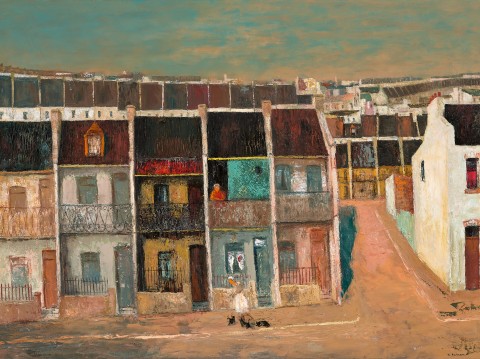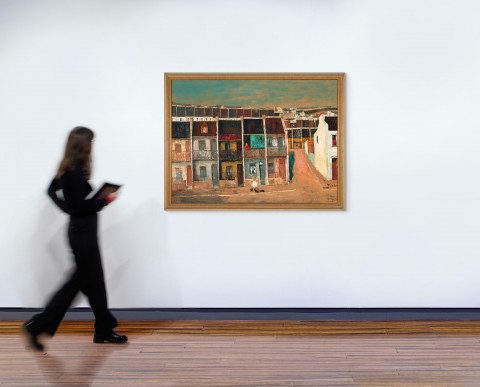PADDINGTON, 1967
SALI HERMAN
oil on canvas
102.5 x 137.5 cm
signed and dated lower right: S. Herman 67
B.N. Beirman, Sydney, by 1971
Holdsworth Galleries, Sydney
Private collection, Sydney, acquired c.1993
Sali Herman, Holdsworth Galleries, Sydney, 8 October 1973, cat. 39
Sali Herman Retrospective, Art Gallery of New South Wales, Sydney, 30 June – 26 July 1981, cat. 92, lent by Mrs B.N. Beirman (label attached verso, as 'Terrace houses')
Thomas, D., Sali Herman, Australian Art Monographs, Georgian House, Melbourne, 1962, pl. 66 (illus.), p. 112
Pearce, B., Sali Herman Retrospective, Art Gallery of New South Wales, Sydney, 1981, cat. 92, pp. 27 (illus.), 80 (as 'Terrace houses')
We are grateful to Brenda Martin Thomas, wife of the late David Thomas AM, for kindly allowing us to reproduce David's writing in this catalogue entry.
The rich vein of humanitarianism that runs throughout Sali Herman’s art finds ideal expression in Paddington, 1967. The older parts of inner Sydney, of Paddington and Woolloomooloo and their Victorian terraces attracted Herman during the forties as much as the people and street life around them. He was so fascinated by their character, both architectural and human, that he produced a series of paintings which today are not only full of the social history of a time now past, but are also fascinating as works of art. It began with McElhone Stairs, 1944 (National Gallery of Australia), which was awarded the 1944 Wynne Prize, accompanied by the howls of outrage that then plagued art prizes. Sydney Scene, 1946 was acquired by Yehudi Menhuhin; The Law Courts, 1946 went to the National Gallery of Victoria (via the Felton Bequest); and the Art Gallery of New South Wales added Near the Docks, 1949 to its collections. Other prominent private and public collectors gained similar works. Mr and Mrs Kenneth Myer chose the engaging Feeding the Cats, 1952, and the state galleries in Adelaide and Perth acquired Reconstruction, 1950 and Woolloomooloo, 1952, respectively.
Herman painted old Sydney, then slums, with sympathy, a fresh eye and a lively mind. ‘To anybody used to pictures of gum trees and the harbour,’ he said, ‘my slum pictures were startling. But I painted houses, because houses are part of people and people are part ofhouses.’1 These pictures are peopled with anecdote – a woman sweeps the front footpath or sits at the window watching the passing parade (as in the present work), a child chases a dog and others play in a vacant lot. For those who lived in these small, often cramped terrace houses, the street offered the place to socialise. Herman also involves the personalities of the houses themselves, as in the peeling paint. As Barry Pearce observed, ‘With a palette knife he plastered and scraped his pigments across the canvas so that the textures took on the very character of the buildings he was portraying.’2 Through paintings such as these, where ideas, technique, and humanism harmonise, Sali Herman has long endeared himself to collectors.
1. Herman, cited in Hetherington, J., Australian Painters: Forty Profiles, F.W. Cheshire, Melbourne, 1963, p. 77
2. Pearce, B., Swiss Artists in Australia, 1777 – 1991, Art Gallery of New South Wales, Sydney, 1991, p. 68
DAVID THOMAS


